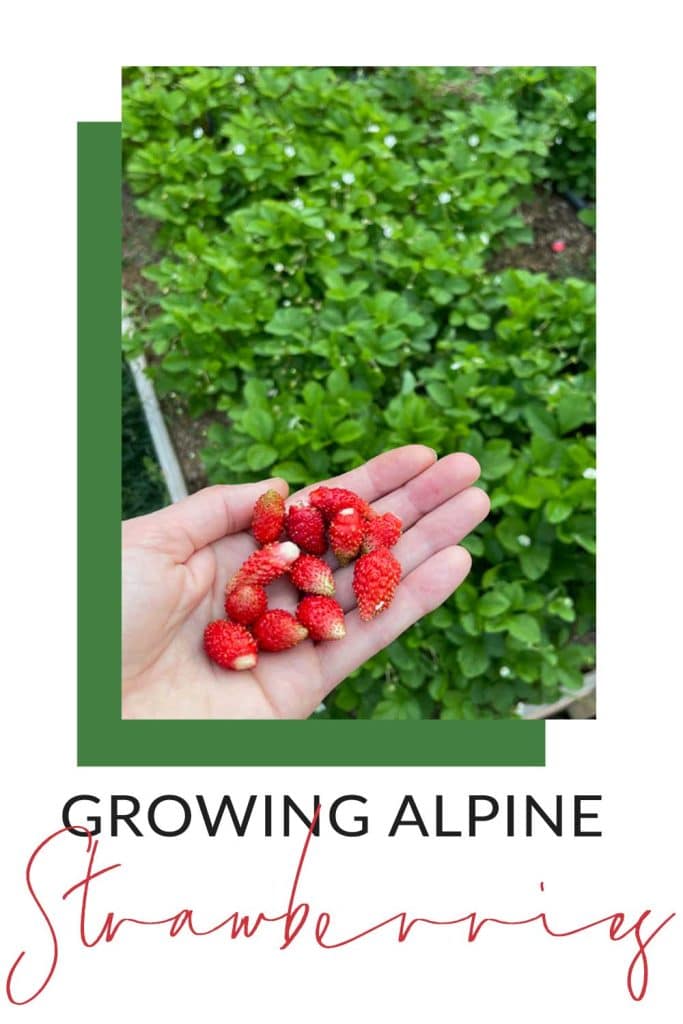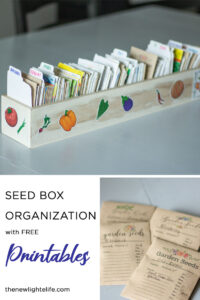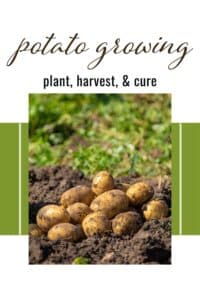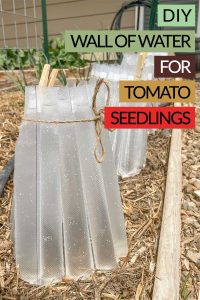A couple of years ago, I ventured into the world of Alpine Strawberries. Quite honestly, I was pretty ignorant of them at the time. Today, I’m sharing all about Alpines and major takeaways to help you make a decision on growing them yourself.
My grandma had a HUGE strawberry patch on the farm and we had an abundance of strawberries all summer. Her hands were perpetually stained red from cutting up strawberries. I have many fond memories of her slightly sweetened strawberries over vanilla ice cream all summer long. AMAZING.
In all my years of gardening, I’ve never had a strawberry patch, so I figured it was high time that I started one.
Starting a Strawberry Patch on a Budget
If you’ve read my blog any time, you probably have gathered that I can sometimes be super cheap. I love our local nurseries and often buy from there but man…I couldn’t stomach the steep price tag on strawberry plants that were ready to start producing berries
How to Multiply Your Strawberry Plants
With that in mind, I have a few ideas for multiplying your strawberry plants.
- Multiply Your Plants (best for Hybrid)- If you invest in a few plants, you can
- Propagate new plants through runners (or stolon). June-bearing strawberries are known to be more prone to sending runners, but you don’t benefit from a continual harvest of berries like an overbearing strawberry.
- Divide Crowns – This is done by splitting the crown up, but there is a chance you may damage the plant. If you opt to do this, be very careful not to damage the roots and leave at least several roots for each divided crown. Strawberry Plants.org has a detailed article about propagation and division.
- Barter/Trade – Plant swaps or Facebook Marketplace are great ways to locate strawberry plants or runners that are relatively inexpensive.
- Plant Heirloom Strawberries – varieties such as the Japanese Hokowase Early Bearing (50 seeds for $15) or Mara des Bois an Everbearing (25 plants for $18). Other heirlooms varieties may also be available in your area. With an heirloom variety (not a hybrid) you can also propagate more plants by saving the seed from the fruit.
My last idea above delves into planting strawberry seeds. Heirloom strawberries may or may not be considered Alpines. In fact, an example of this is found at BackyardBerryPlants.com, which offers heirloom strawberries, (5 of the 11 strawberry plants are NOT Alpines) but all 11 are considered heirlooms.
I was intrigued by alpine strawberries, so I opted to start them from seeds early in the year 2021.
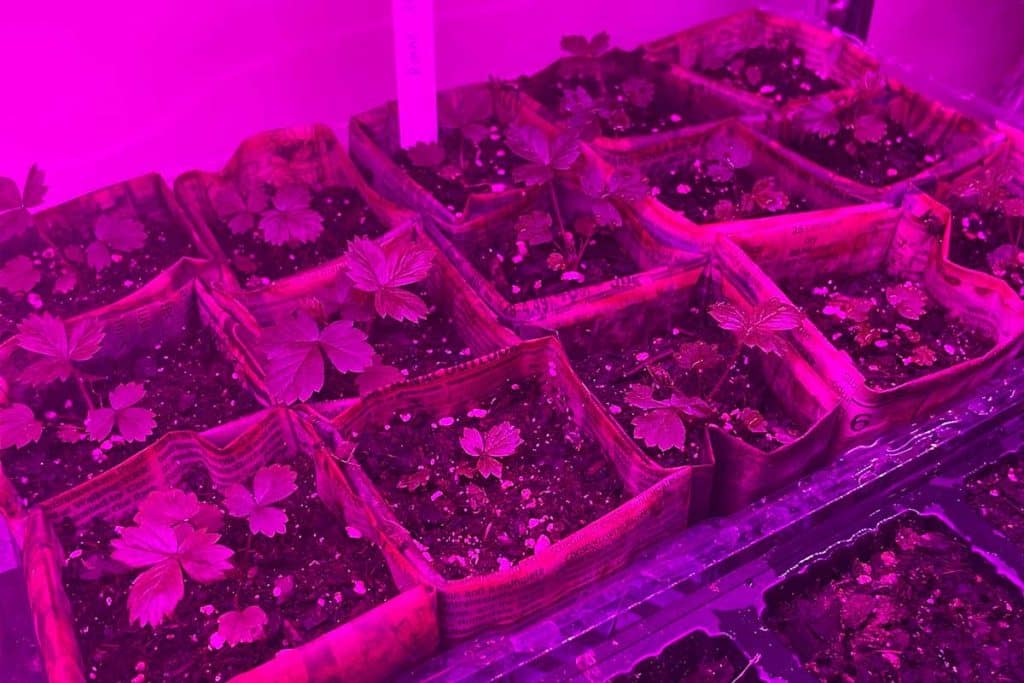
What are Alpine Strawberries?
Alpine strawberry (Fragaria vesca) may sometimes be called wild strawberry, or woodland strawberry, they are native to Europe and Asia. They are known for:
- Exceptional Flavor – they are intensely sweet and have a distinct aroma. The best way to characterize the flavor is a combination of pineapple and berries with a floral twist. Yum!
- Hardy Plants – tolerant to cold weather and partial shade
- Delicate Fruit – Alpines are extremely delicate and do not have the substance of a cultivated strawberry. I find they are best eaten straight off the plant or as a garnish shortly after picking.
- Prolific – though the fruit is not substantial compared to strawberries you may be used to, the plants produce many many strawberries, making them a beautiful addition to landscapes
- Nutritious – just like their hybrid counterparts, alpines are loaded with Vitamin C, antioxidants, and fiber

Alpine Strawberry Varieties
There are many different varieties of alpine strawberries available to gardeners, each with its own unique characteristics and flavor profile. Some popular varieties include:
- Alexandria: A red-fruited variety is known for its high productivity and deep red color.
- Reine des Vallees: This red variety is unusually cold and hardy, it produces all summer long.
- Mignonette: A French heirloom variety producing sweet, scarlet red fruit.
- Pineapple Crush: A yellow-fruited variety with a hint of pineapple in its flavor.
- Yellow Wonder: Another yellow-fruited variety, known for its sweetness and aromatic qualities.
Growing a mix of red and yellow varieties can provide an interesting diversity of flavors and colors in your harvest.
I started Alexandria and Reine des Vallees in my seed trays in early February of 2021. By March, they were transplanted into my newspaper pots and planted out in the garden in mid-April. The Reine des Vallees took off like wildfire while the Alexandria struggled and didn’t make it long after planting in the garden.
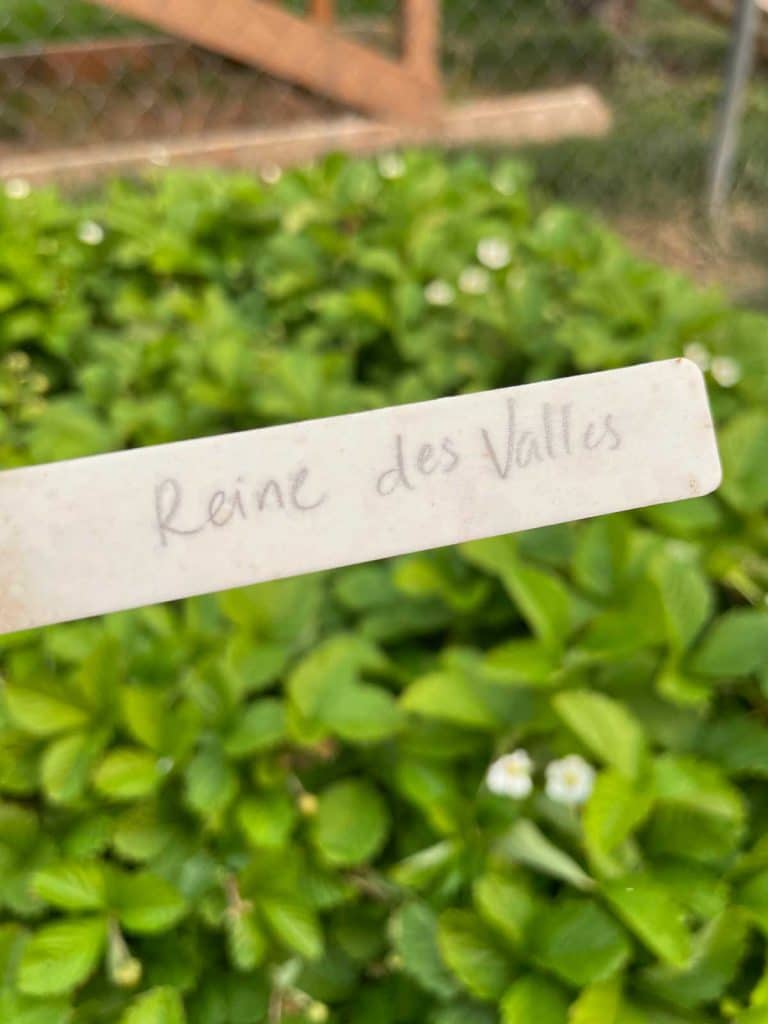
Planting Alpine Strawberries
Growing from Seed
Starting alpines from seed is incredibly easy to do, which makes them a perfect solution to inexpensively start a new strawberry patch. Seeds should be sown indoors under grow lights in late winter, as they can take several weeks to germinate. The ideal soil temperature for germination is between 65 and 75 degrees Fahrenheit. I used a heat mat to keep the seed tray warm enough in our cold basement.
Alternatively, seeds can be started outdoors in a protected area, such as a cold frame or raised bed. Keep the seeded area moist and only cover the seeds very lightly with soil or sand after planting, as they need light to germinate.
Starting with Transplants
If you prefer to start with more mature plants, you can purchase transplants from a specialty nursery. These alpine strawberry plants are sold as either bare-root plants or potted “plugs” and will produce berries much faster than when planted from seed. To plant alpine strawberry transplants, space them about 8 to 10 inches apart in the center. Be sure to keep the crown of the plant (where the shoot system emerges from the root system) above the ground when planting, and mulch the newly planted alpine strawberry plants with a 1 to 2-inch thick layer of shredded leaves, straw, or compost.
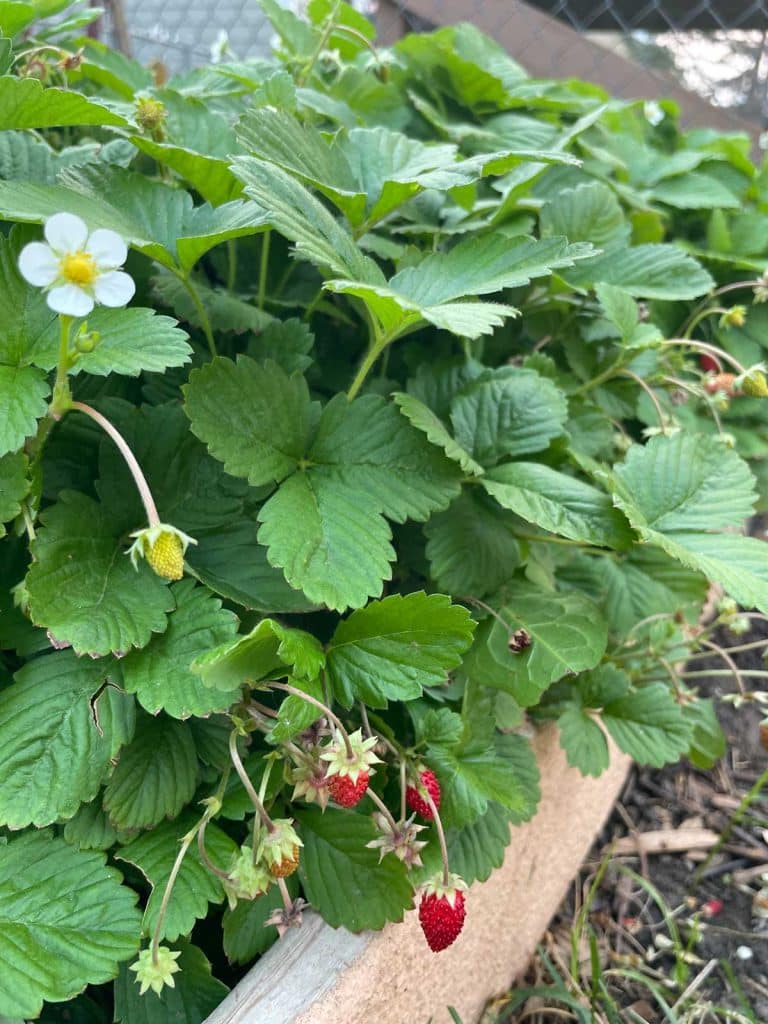
Soil & Site Requirements
Alpine strawberries thrive in well-drained, fertile soil with a slightly acidic pH of 5.5 to 7.0. They can tolerate a range of light conditions, from full sun to partial shade. In fact, they earned their name “woodland strawberries” due to their ability to tolerate more shade than regular strawberries.
Currently, I have alpines planted in a fully shaded side of my yard. This is a neglected garden bed that rarely gets watered. To be honest, I’ve just ignored them, which I’ll get into why at the end. Some plants are still alive but fruit production and spreading are significantly reduced in full shade.
When choosing a location for your alpine strawberries, consider an area with moderate shade, as well as a spot where the plants can be easily accessed for harvesting.
Caring for Alpine Strawberry Plants
Watering & Mulching
Alpine strawberries require consistent moisture to produce a healthy crop of berries. It’s important to water them regularly, particularly during dry periods. To help conserve moisture and protect the shallow roots of the plants, it is best to use organic mulch such as shredded leaves, straw, or compost.
Fertilizing
Alpine strawberries are heavy feeders and benefit from the addition of compost or a balanced granular fertilizer at the start of each growing season before the plants come into flower. My preferred method to fertilize my beds is by top-dressing the ground with compost in early spring, and spraying the foliage with diluted fish emulsion mid-summer.
Pruning & Maintenance
Alpine strawberries are very low-maintenance plants, requiring minimal pruning and upkeep. You may want to remove early flowers from first-year plants to encourage the development of a strong root system. Speaking of my experience with Riene des Vallees, the plants simply take off and no pruning was needed.
Regardless of your variety, once the plants are established, allow the fruit to mature and harvest regularly to keep the plants productive and prevent fungal diseases.
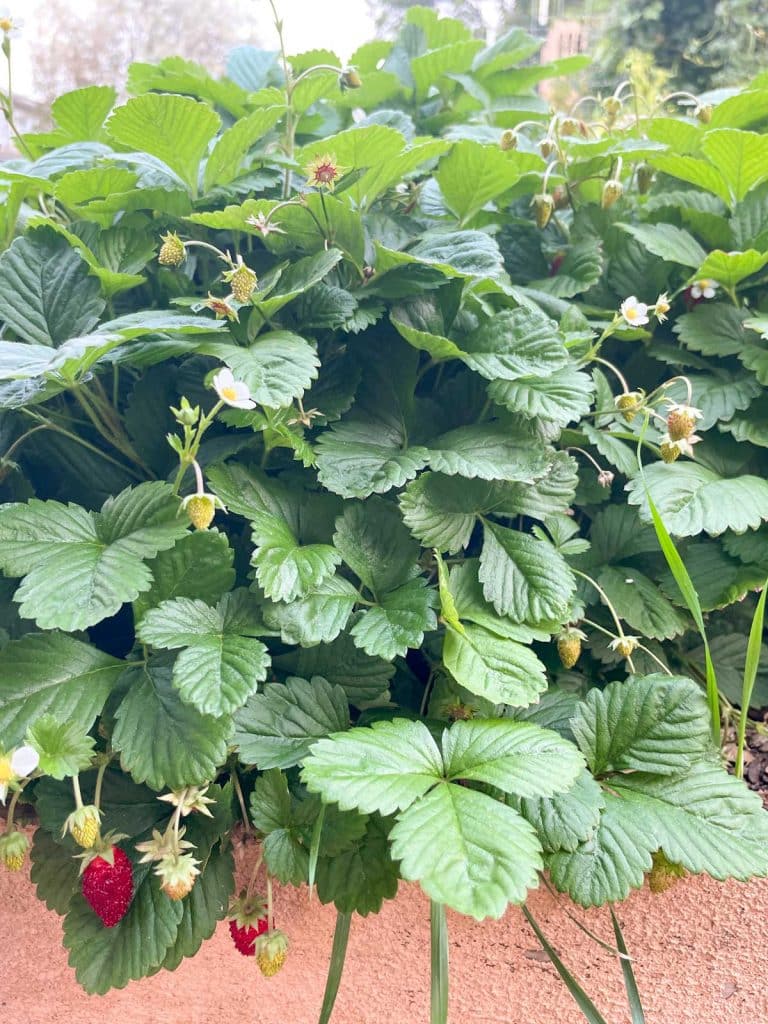
Pest & Disease Control
While alpine strawberries are relatively hardy and resistant to many common pests and diseases, they can still be affected by issues such as aphids, spider mites, and slugs. To control pest populations, use organic methods such as insecticidal soap, neem oil, or pyrethrin sprays. Encourage beneficial insects, such as ladybugs and lacewings, by planting a variety of pollinator-friendly flowers near your alpine strawberries.
Harvesting Alpine Strawberries
One of the most rewarding aspects of growing alpine strawberries is the continual harvest of berries throughout the summer. The fruits are small, usually only an inch or less in length, but they are produced consistently all season long.
This was a favorite little stop in my garden every other day. A little tasty snack as a reward for my gardening endeavors was found through my alpines. By the end of summer, I was asking friends to come and pick berries. My alpines simply would not stop, a great problem to have if you ask me.
To harvest, simply pick the ripe berries as they become ready. The best-tasting and ripest fruit will nearly fall off the plant. If you tug on the fruit, your strawberry will have a more tart flavor. Just be sure to check for ripe fruit every day or two, as the small size of the berries and the abundant foliage can make them easy to miss.
Enjoying Your Alpine Strawberries
I’ve already touched on this, but alpines are so very delicate. I find they are best picked right before consumption. They are delicious as a garnish for salads but I did not personally try them in desserts, jam, syrups, or baked goods (due to their small size and unsubstantial insides. 95% of the time, we ate them straight from the plant as a sweet, garden-fresh treat.
Overwintering Alpine Strawberries
As I mentioned before, alpine strawberries are perennial plants that are hardy to -20 degrees Fahrenheit. If you live in a colder climate, you can protect your plants during the winter by mulching them with a layer of straw. In the spring, remove the mulch as temperatures begin to warm and new growth emerges.
Growing Alpine Strawberries in Containers
If you have limited garden space or prefer container gardening, alpine strawberries make beautiful container plants. They can be grown in window boxes, hanging baskets, or patio planters, provided they have sufficient room and good drainage. When potting alpine strawberries, ensure the crown of the plant remains above the soil and use a well-draining, fertile potting mix.
Where Did My Alpines Go?
I told you earlier that I planted my seedlings out in the garden in mid-April. By July, they looked like this:
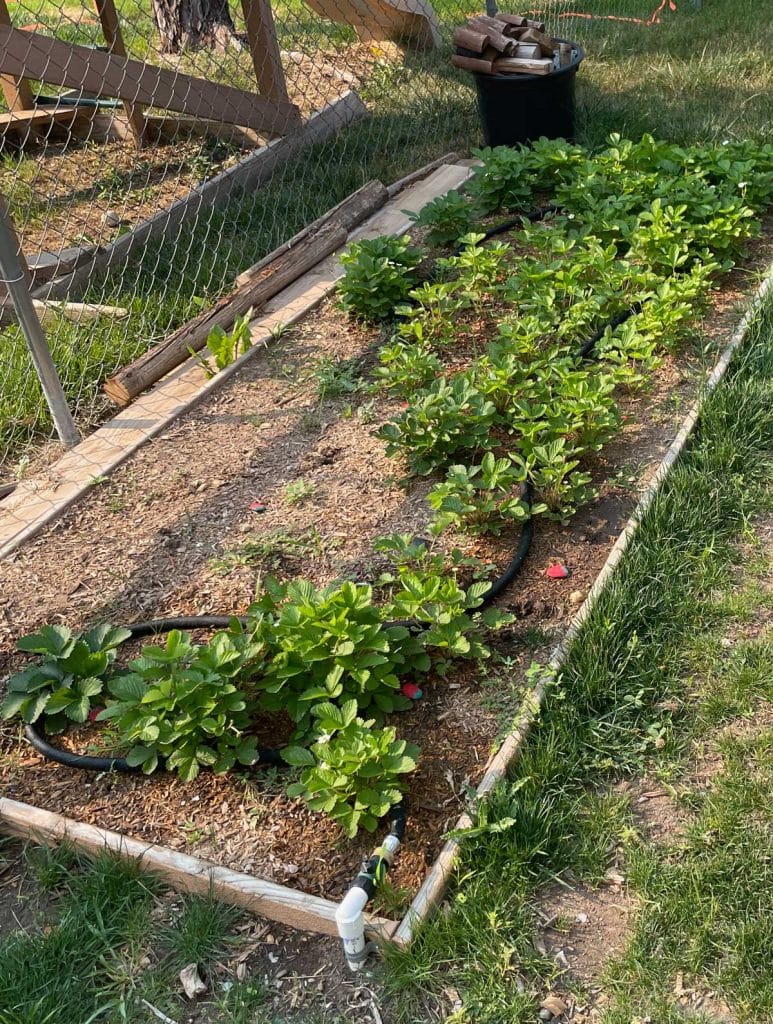
I focused my planting on where the soaker hose would be placed and the plants just went crazy! By early August, I was picking berries nearly every other day.
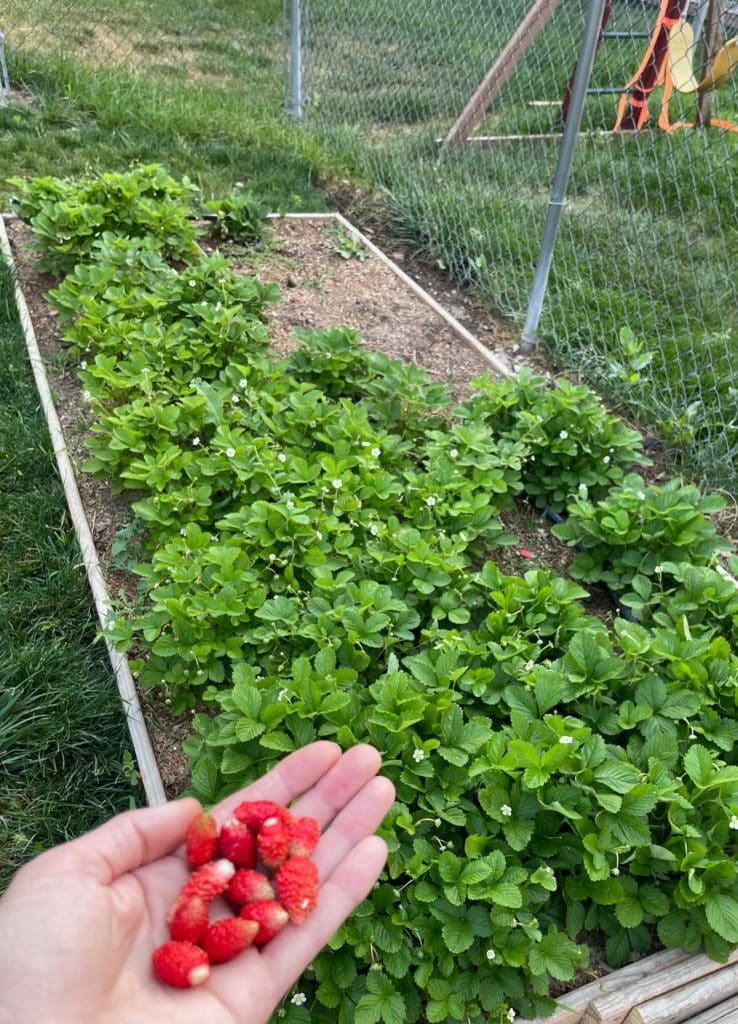
As much as I loved the flavor and the beauty of my alpines, I REALLY wanted substantial strawberries for all those yummy summer treats. Towards the end of that first summer I had planted my strawberry seedlings I made the decision to move my alpines to another bed (the one I mentioned is neglected). If you’re a sleuth, you can find the video on YouTube, but I’m pretty cringy in it… so you have to look for it yourself. Ha!
In the alpine’s place, I planted a hybrid strawberry, Albion strawberries which are alive and kicking it (and have amazing flavor!)
But still, here I am two years later, missing those little alpines. The remaining plants in my side bed will be transplanted into pots so we can feast on alpines again.
In Conclusion
Having come full circle on the alpine strawberries, I miss their amazing flavor and easy growing. With virtually no work at all, I was able to harvest berries throughout the first summer of planting them. They have beautiful and full foliage that I miss as well.
Each type of strawberry, be it alpines, heirlooms, or hybrid strawberries has its own drawbacks. But hopefully, with all this information and tips I’ve shared with you, you’ll be well on your way to enjoying the delightful taste and beauty of at least some alpine strawberries in your own backyard.

